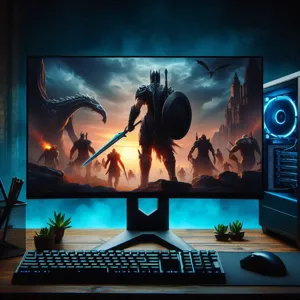In the ever-evolving world of gaming, having the right monitor can make all the difference between a good experience and a great one.
However, while top-tier gaming monitors often come with eye-watering price tags, you don’t have to sacrifice quality or performance for affordability. In this blog post, we’re diving into the top five gaming monitors available for under $300 that deliver exceptional visuals, rapid refresh rates, and immersive experiences—all without breaking the bank. whether you’re an aspiring esports competitor or a casual gamer looking to upgrade your setup, these monitors combine style and functionality, ensuring every pixel pops and every frame flows seamlessly. Get ready to elevate your gaming sessions while keeping your budget intact!
1. Introduction: Why a Good Monitor Matters for Gaming

When it comes to gaming, the monitor you choose can be just as important as the graphics card or processor in your rig. A high-quality gaming monitor can significantly enhance your overall experience, providing stunning visuals, smooth gameplay, and a competitive edge. Imagine immersing yourself in expansive worlds with vibrant colors, crisp details, and fluid motion—this is what a good monitor can offer.
The right display can mean the difference between spotting an enemy hidden in the shadows or being caught off-guard. With advancements in technology, gaming monitors now come equipped with features like high refresh rates, low response times, and adaptive sync technologies, all designed to elevate your gaming sessions. These features not only improve your performance but also reduce eye strain during those marathon gaming nights.
Moreover, a good monitor can enhance the aesthetic of your gaming setup, making it a centerpiece that reflects your personality and style. Whether you’re racing through a virtual landscape, exploring intricate role-playing games, or battling foes in fast-paced shooters, a monitor that delivers sharp images and vibrant colors makes all the difference.
In this guide, we’ll explore the top 5 gaming monitors under $300 that provide exceptional performance without draining your wallet. Get ready to game in style and discover how a budget-friendly monitor can elevate your gaming experience to new heights!
2. Key Features to Look for in a Gaming Monitor
When searching for the perfect gaming monitor under $300, it’s essential to prioritize key features that will enhance your gaming experience without straining your budget. Here are the critical elements to consider:
1. **Refresh Rate**: The refresh rate, measured in hertz (Hz), determines how many frames per second the monitor can display. A higher refresh rate, such as 144Hz or even 240Hz, provides smoother gameplay and a competitive edge in fast-paced games. This feature minimizes motion blur and ghosting, making your gaming sessions more immersive.
2. **Response Time**: Look for a monitor with a low response time, ideally 1ms to 5ms. This ensures that pixels change quickly, reducing ghosting and blurring during intense action scenes. A quick response time is crucial for competitive gaming, where every millisecond counts.
3. **Resolution**: While full HD (1920×1080) is standard in this price range, some monitors offer higher resolutions like 1440p. A higher resolution provides sharper images and more detailed graphics, enhancing your overall visual experience. However, balance this with refresh rate and response time to ensure you’re not sacrificing performance for quality.
4. **Panel Type**: The type of panel used in a monitor significantly impacts color accuracy, viewing angles, and response times. TN panels typically offer faster response times but poorer color reproduction, while IPS panels provide better colors and viewing angles, albeit with slightly slower response rates. VA panels strike a balance, offering decent color and contrast levels. Choose based on your gaming preferences and whether you value speed or color fidelity more.
5. **Adaptive Sync Technology**: Features like AMD FreeSync or NVIDIA G-Sync help to eliminate screen tearing and stuttering by syncing the monitor’s refresh rate with your graphics card’s output. While G-Sync might be out of reach in this price category, many budget monitors support FreeSync, allowing for a smoother gaming experience without the annoyance of visual artifacts.
By focusing on these key features, you can find a gaming monitor that not only fits within your budget but also elevates your gaming experience, ensuring you enjoy every moment of your gaming adventures in style!
3. Overview of Budget-Friendly Gaming Monitors

When diving into the world of budget-friendly gaming monitors, it’s essential to balance performance, features, and price—a task that can be daunting with so many options available. Fortunately, the market has evolved, and today’s gamers can find impressive specifications without straining their wallets.
Budget gaming monitors typically fall within the sweet spot of $200 to $300, offering features that were once only found in high-end models. Many of these monitors boast refresh rates of 144Hz or higher, providing smooth gameplay and a competitive edge in fast-paced titles. Additionally, a response time of 1ms to 3ms ensures that ghosting and motion blur are minimized, allowing you to react instantly to in-game actions.
Resolution plays a crucial role in visual fidelity, and while Full HD (1920×1080) remains the standard in this price range, some models also offer Quad HD (2560×1440) displays, giving gamers a more immersive experience with sharper images and vibrant colors. Look for monitors with IPS panels for wider viewing angles and better color accuracy, or consider VA panels for deeper blacks and higher contrast ratios.
Connectivity options are another key consideration. Many budget monitors come equipped with multiple ports such as HDMI, DisplayPort, and even USB hubs, making it easier to connect your gaming rig, console, and peripherals. Furthermore, features like FreeSync or G-Sync compatibility can help eliminate screen tearing and create a seamless gaming experience.
In summary, the landscape of budget-friendly gaming monitors is rich with choices that cater to different preferences and gaming styles. With the right research, you can find a monitor that not only fits your budget but also elevates your gaming experience without compromising on quality or performance.
4. Monitor #1: Specifications and Review
Introducing our top pick for gaming enthusiasts on a budget: the **Acer R240HY**. This sleek 24-inch IPS monitor combines stunning visuals with impressive performance, making it a standout choice for gamers who want to elevate their gaming experience without emptying their wallets.
**Specifications:**
– **Screen Size:** 24 inches
– **Resolution:** Full HD 1920 x 1080 pixels
– **Panel Type:** IPS (In-Plane Switching)
– **Refresh Rate:** 60Hz
– **Response Time:** 4ms (GTG)
– **Brightness:** 250 nits
– **Connectivity:** HDMI, DVI, VGA
– **Aspect Ratio:** 16:9
**Review:**
The Acer R240HY boasts an ultra-thin bezel that not only enhances its aesthetic appeal but also provides an immersive viewing experience, allowing gamers to easily set up a multi-monitor configuration if desired. The IPS panel offers vibrant colors with wide viewing angles, ensuring that your games look stunning from any position in the room.
While the refresh rate sits at a modest 60Hz, it is more than adequate for casual gaming and fast-paced titles, providing smooth motion and minimal ghosting, thanks to its 4ms response time. The monitor also features excellent color accuracy, which is a real treat for gamers who value detailed graphics and immersive worlds.
In terms of connectivity, the R240HY offers a range of options, including HDMI and DVI ports, making it versatile enough to connect with various gaming consoles and PCs.
Overall, the Acer R240HY is a fantastic choice for budget-conscious gamers seeking a quality monitor that delivers both performance and style. Its sleek design, vibrant display, and reliable performance set it apart in the competitive landscape of gaming monitors under $300. With the Acer R240HY, you can game in style without breaking the bank!
5. Monitor #2: Specifications and Review

Stepping into the spotlight is the **Acer R240HY**, a stunning 23.8-inch Full HD monitor that seamlessly combines sleek design with impressive performance, all while fitting snugly within your budget. With a vibrant IPS panel, this monitor delivers an extraordinary color accuracy and wide viewing angles, making it perfect for both immersive gaming sessions and daily productivity tasks.
**Specifications:**
– **Screen Size:** 23.8 inches
– **Resolution:** 1920 x 1080 (Full HD)
– **Panel Type:** IPS
– **Refresh Rate:** 60Hz
– **Response Time:** 4ms
– **Connectivity:** HDMI, VGA, and DVI ports
– **Brightness:** 250 nits
– **Aspect Ratio:** 16:9
– **Adaptive Sync:** Yes (supports AMD FreeSync)
**Review:**
When it comes to aesthetics, the Acer R240HY boasts an ultra-thin bezel that provides an almost borderless viewing experience, allowing you to focus entirely on the action unfolding on screen. The monitor’s sleek, minimalist design means it will sit elegantly on any desk setup without overwhelming your space.
Performance-wise, the IPS technology shines through, offering vibrant colors that pop and deep blacks that enhance contrast. This is particularly advantageous in gaming, where visual fidelity can make a significant difference in your experience. Whether you’re exploring expansive open worlds or engaging in fast-paced multiplayer combat, the clarity and color depth will keep you immersed for hours on end.
While the 60Hz refresh rate may not cater to hardcore competitive gamers looking for lightning-fast action, it strikes a solid balance between casual gaming and everyday use. The 4ms response time minimizes motion blur, ensuring that your gameplay remains smooth and responsive. Plus, with support for AMD FreeSync, you can enjoy tear-free gaming, provided you’re using a compatible graphics card.
Connecting the R240HY to your devices is a breeze, thanks to its versatile connectivity options. Whether you’re plugging in a console or a gaming PC, you can easily switch between devices without hassle.
In summary, the Acer R240HY is a fantastic choice for gamers looking to elevate their gaming experience without exceeding a budget of $300. Its stylish design, impressive color accuracy, and solid performance make it a well-rounded option for anyone wanting a reliable monitor for gaming, streaming, or general use. So, if you’re ready to game in style without breaking the bank, this monitor deserves a spot on your shortlist!
6. Monitor #3: Specifications and Review
Our third pick in the lineup of top gaming monitors under $300 is the **Acer XFA240**, a robust choice that combines performance, versatility, and style. This 24-inch monitor is a gamer’s dream, offering a seamless experience without compromising on quality or budget.
**Specifications:**
– **Display Size:** 24 inches
– **Resolution:** 1920 x 1080 (Full HD)
– **Refresh Rate:** 144Hz
– **Response Time:** 1ms (GTG)
– **Panel Type:** TN (Twisted Nematic)
– **Connectivity:** DisplayPort, HDMI, DVI, and VGA
– **Adaptive Sync Technology:** AMD FreeSync
– **Brightness:** 350 nits
– **VESA Mount Compatible:** Yes
**Review:**
From the moment you set up the Acer XFA240, it’s clear that this monitor is built with gamers in mind. The sleek design features a matte finish that minimizes glare, making it an excellent choice for bright gaming environments. The 144Hz refresh rate delivers ultra-smooth gameplay, providing a competitive edge in fast-paced titles. Coupled with a lightning-fast 1ms response time, this monitor helps eliminate motion blur, allowing for precise movements and reactions during critical moments in the game.
Color reproduction is impressive for a TN panel, with vibrant hues and sharp contrasts that bring your favorite games to life. While it may not match the color depth of more expensive IPS panels, it still holds its own, especially in the realm of competitive gaming where speed is paramount.
One of the standout features of the Acer XFA240 is its support for AMD FreeSync technology, which synchronizes the monitor’s refresh rate with your graphics card’s frame rate. This effectively reduces screen tearing and stuttering, offering a more fluid gaming experience. Whether you’re exploring vast open worlds or engaging in intense multiplayer battles, you’ll appreciate the smooth visuals this monitor provides.
The connectivity options are plentiful, making it easy to connect to various gaming consoles and PCs. The inclusion of both HDMI and DisplayPort ensures compatibility with a wide range of devices, while the VESA mount compatibility offers flexibility for those looking to optimize their desk space.
In terms of ergonomics, the monitor boasts an adjustable stand that allows for height, tilt, and swivel adjustments, ensuring that you can achieve the most comfortable viewing angle during long gaming sessions.
Overall, the Acer XFA240 is a fantastic gaming monitor that excels in performance and functionality, making it a top choice for gamers looking to enhance their setup without exceeding the $300 mark. Whether you’re a casual gamer or a competitive player, this monitor will undoubtedly elevate your gaming experience.
7. Monitor #4: Specifications and Review

In the competitive landscape of gaming monitors, the **Acer R240HY** stands out as a remarkable choice for gamers seeking both performance and affordability. Priced just below the $300 mark, this monitor delivers exceptional value with its impressive specifications and sleek design.
**Specifications:**
– **Screen Size:** 23.8 inches
– **Resolution:** Full HD (1920 x 1080)
– **Refresh Rate:** 60Hz
– **Response Time:** 4ms (GTG)
– **Panel Type:** IPS
– **Brightness:** 250 nits
– **Ports:** HDMI, DVI, VGA, and audio out
– **Aspect Ratio:** 16:9
The Acer R240HY features an IPS panel, which is a significant advantage for gamers who appreciate vibrant colors and wide viewing angles. With a resolution of 1920 x 1080 pixels, this monitor provides sharp and detailed visuals, enhancing the gaming experience whether you’re exploring vast landscapes or engaging in fast-paced action.
One of the standout features of the R240HY is its ultra-thin bezels, giving it a modern and stylish look that will complement any gaming setup. The 60Hz refresh rate and 4ms response time are perfectly adequate for casual gamers, ensuring smooth gameplay without the ghosting that can occur in faster-moving scenes. While it may not compete with higher-end models boasting 144Hz refresh rates, it performs admirably for the price point.
In terms of performance, users have praised the Acer R240HY for its ability to reproduce colors accurately, making it a fantastic option for both gaming and media consumption. Whether you’re diving into a colorful platformer or an atmospheric RPG, the monitor’s IPS technology ensures that colors pop and details are not lost.
The build quality is solid, and the adjustable stand allows for tilt adjustments, providing comfortable viewing angles during long gaming sessions. While it lacks advanced features like G-Sync or FreeSync, the R240HY remains a reliable choice for gamers looking for a straightforward, quality monitor without the bells and whistles.
In conclusion, the Acer R240HY is a fantastic option for gamers on a budget. With its impressive display quality, sleek design, and solid performance, it proves that you don’t have to spend a fortune to elevate your gaming experience.
8. Monitor #5: Specifications and Review
As we round out our list of top gaming monitors under $300, we present the **Acer R240HY** — a stylish yet powerful option for both casual and dedicated gamers. With its sleek design and impressive specifications, this monitor stands out as a strong contender in the budget-friendly gaming category.
**Specifications:**
– **Screen Size**: 23.8 inches
– **Resolution**: Full HD (1920 x 1080)
– **Panel Type**: IPS
– **Refresh Rate**: 60Hz
– **Response Time**: 4ms (GTG)
– **Brightness**: 250 cd/m²
– **Connectivity**: HDMI, DVI, VGA
The Acer R240HY boasts an ultra-slim profile and an almost bezel-less design that not only provides a modern aesthetic but also maximizes your screen real estate. Gamers will appreciate the IPS panel technology, which delivers vibrant colors and wide viewing angles, ensuring that every detail is sharp and clear whether you’re playing on your couch or gaming chair.
In terms of performance, the 60Hz refresh rate may not be the highest on the market, but it offers smooth visuals for most gaming scenarios. The 4ms response time is also commendable, minimizing motion blur during fast-paced scenes. While competitive gamers might prefer a higher refresh rate for intensified gameplay, the R240HY caters perfectly to casual gaming and everyday use.
One of the standout features of this monitor is its excellent color accuracy out of the box, making it a fantastic choice for those who appreciate stunning visuals. Whether you’re exploring lush landscapes in an open-world game or engaging in fierce battles, the colors truly pop.
Additionally, Acer has included a Blue light Filter and flicker-less technology, which help reduce eye strain during extended gaming sessions. This is particularly beneficial for night owls who love to game into the early hours.
Overall, the Acer R240HY combines style, performance, and affordability, making it a fantastic option for gamers looking to elevate their setup without stretching their budget. With its reliable performance and attractive design, this monitor ensures that you can game in style without breaking the bank!
9. Comparing the Top 5: Pros and Cons
When it comes to choosing the perfect gaming monitor under $300, it’s essential to weigh the pros and cons of each option to find the one that best suits your gaming style and setup. Below, we break down the key features of our top five picks, highlighting what makes each monitor shine, as well as any potential drawbacks to consider.
**1. AOC 24G2**
*Pros:* This monitor offers a stunning 144Hz refresh rate and a 1ms response time, ensuring smooth gameplay with minimal motion blur. Its IPS panel provides vibrant colors and wide viewing angles, making it perfect for both gaming and media consumption. Additionally, the sleek design and adjustable stand add to its appeal.
*Cons:* While it excels in performance, some users may find that the built-in speakers lack depth and power, necessitating external audio solutions for a more immersive experience.
**2. Acer XFA240**
*Pros:* With its 144Hz refresh rate and FreeSync support, the Acer XFA240 delivers a stutter-free experience for competitive gamers. The monitor also boasts a height-adjustable stand, allowing for comfortable viewing angles during long gaming sessions.
*Cons:* The TN panel, while fast, compromises color accuracy and viewing angles compared to IPS monitors, which may not satisfy those who prioritize graphic fidelity.
**3. ASUS VG248QG**
*Pros:* This monitor is a gamer’s dream, featuring an impressive 165Hz refresh rate with G-Sync compatibility, which can significantly enhance your gaming experience. Its rapid 0.5ms response time minimizes ghosting, and the customizable RGB lighting adds a stylish touch to your gaming setup.
*Cons:* The monitor’s built-in color calibration may not be as robust as some competitors, requiring manual adjustments for optimal color performance.
**4. LG 24GN600-B**
*Pros:* The LG 24GN600-B stands out with its vibrant IPS display, providing excellent color accuracy and wide viewing angles. It also supports AMD FreeSync, making it a great choice for gamers looking to reduce screen tearing. The sleek design and thin bezels make it an attractive addition to any setup.
*Cons:* While it has solid features, some users might find the limited brightness range insufficient for very bright environments.
**5. ViewSonic XG2405**
*Pros:* This monitor combines affordability with high performance, offering a 144Hz refresh rate and FreeSync support. Its IPS panel provides impressive color reproduction and viewing angles, making it versatile for both gaming and productivity. The ergonomic design adds extra comfort for prolonged use.
*Cons:* The response time, while decent, may not compete with TN panels in fast-paced competitive gaming scenarios, potentially leading to slight motion blur during rapid movements.
In summary, each of these gaming monitors has its unique strengths and weaknesses, catering to various preferences and gaming styles. By understanding the pros and cons of each option, you’ll be better equipped to choose the ideal monitor that complements your gaming experience without emptying your wallet. Happy gaming!
10. Tips for Choosing the Right Monitor for Your Gaming Setup
When it comes to elevating your gaming experience, the right monitor can make all the difference. With a plethora of options available, it’s essential to consider several factors to ensure you select a monitor that not only fits your budget but also enhances your gameplay. Here are some key tips to guide you in choosing the perfect gaming monitor for your setup.
**1. Determine Your Gaming Style:**
Are you an action-packed FPS enthusiast or a strategy game master? Each genre can benefit from different monitor features. Fast-paced games typically require a monitor with a high refresh rate (at least 144Hz) to provide smooth motion and reduce motion blur. Conversely, if you enjoy immersive RPGs or adventure games, you might prioritize a monitor with vibrant colors and impressive resolution.
**2. Resolution Matters:**
While budget monitors often feature 1080p (Full HD) resolution, you may want to consider 1440p (QHD) if your system can handle it. A higher resolution provides sharper images and a more immersive gaming experience. However, keep in mind the performance of your graphics card; it should be capable of supporting the resolution you choose for optimal gameplay.
**3. Refresh Rate and Response Time:**
A monitor’s refresh rate, measured in hertz (Hz), indicates how many times the screen refreshes per second. A higher refresh rate, such as 144Hz or even 240Hz, translates to smoother visuals during fast-paced action. Similarly, a low response time (ideally 1ms to 5ms) minimizes ghosting and blurring during gameplay, ensuring a crisp and clear image.
**4. Panel Type:**
The type of panel (IPS, TN, or VA) significantly influences color accuracy, viewing angles, and response times. IPS panels are known for their excellent color reproduction and wide viewing angles, making them a great choice for cooperative gaming. TN panels typically have faster response times but may lack color depth, while VA panels offer deeper blacks and contrast but can have slower response times.
**5. Connectivity Options:**
Ensure the monitor has the ports that match your gaming setup. Look for HDMI and DisplayPort options, as well as USB ports for peripherals. If you plan to use multiple devices, having a monitor with multiple input options will save you from constantly swapping cables.
**6. Consider Ergonomics and Design:**
Lastly, think about how the monitor fits into your gaming environment. Adjustable stands that allow you to change height, tilt, and swivel can enhance comfort during long gaming sessions. Additionally, a sleek design with thin bezels can contribute to a more immersive experience, making the monitor a stylish addition to your setup.
By keeping these factors in mind, you can make an informed decision and find a gaming monitor under $300 that suits your needs and enhances your gaming adventures, all while staying within budget. Happy gaming!
11. Accessories to Enhance Your Gaming Experience
When it comes to creating the ultimate gaming setup, the right accessories can significantly enhance your experience, taking it to the next level without straining your budget. While a top-notch gaming monitor is crucial, the addition of well-chosen accessories can make all the difference in how you game.
**1. Quality Headset:** A good gaming headset immerses you in the action, delivering crisp audio that can give you a competitive edge. Look for headsets with surround sound capabilities to pinpoint enemy locations or cues that add to the atmosphere of your favorite games. Comfort is key, too—choose models with padded ear cups and adjustable bands for those long gaming sessions.
**2. Mechanical keyboard:** A responsive mechanical keyboard not only improves your gaming performance but also enhances your overall experience with tactile feedback and satisfying keystrokes. Opt for one with customizable RGB lighting to match your monitor and create a unified, aesthetically pleasing look for your setup.
**3. Gaming Mouse:** Precision is vital in gaming, and a high-quality gaming mouse can provide that edge. Look for a mouse with customizable DPI settings, programmable buttons, and ergonomic design. This will enhance your control during intense gameplay, allowing you to react faster and achieve better results.
**4. Mouse Pad:** An oversized mouse pad can create a seamless surface for your mouse, improving its tracking and allowing for expansive movements without the need to constantly reposition. Consider a mouse pad with a non-slip base and a smooth surface for optimal glide.
**5. Monitor Stand or Mount:** Elevating your gaming monitor with a stand or mount can improve your ergonomic setup, reducing strain on your neck and eyes. Adjustable stands allow you to find the perfect height and angle, ensuring you remain comfortable during long gaming sessions.
**6. Cable Management Solutions:** Keeping your gaming area tidy not only looks good but also helps maintain focus. Invest in cable ties, sleeves, or clips to organize and hide those pesky cords. A clean setup can improve your gaming experience and create a more inviting atmosphere.
By investing in these accessories, you can elevate your gaming experience without breaking the bank. Each addition complements your gaming monitor, creating a cohesive and enjoyable environment that enhances your gameplay and keeps you coming back for more.
12. Conclusion: Finding Your Perfect Budget Gaming Monitor
In conclusion, finding the perfect budget gaming monitor doesn’t have to be a daunting task. With a budget of under $300, you can access an impressive spectrum of options that deliver both performance and style. The key is to identify what aspects of a monitor are most critical to your gaming experience—be it refresh rates, resolution, response times, or screen size.
As we’ve explored in this guide, today’s market offers a variety of monitors that excel in these categories without compromising your wallet. Whether you’re an esports enthusiast craving ultra-responsive gameplay, a casual gamer who enjoys immersive visuals, or someone looking to enhance their streaming setup, there’s a monitor tailored to meet your needs.
Remember to keep in mind your gaming habits and preferences when making your selection. Are you drawn to fast-paced action games or do you prefer engaging narratives in story-driven titles? Understanding your gaming style will guide you towards a monitor that elevates your experience, allowing you to fully immerse yourself in the worlds you explore.
So, go ahead and compare the top picks we’ve discussed, read user reviews, and consider the features that matter most to you. With the right monitor, you’ll not only enhance your gaming sessions but also enjoy a visually stunning experience that invigorates every pixel on your screen. Game in style, stay within your budget, and get ready to take your gameplay to the next level!
13. FAQs About Gaming Monitors Under $300
As you embark on your quest for the perfect gaming monitor without straining your wallet, it’s natural to have questions. Here are some of the most frequently asked questions about gaming monitors in this affordable price range, designed to help you make an informed decision.
**1. What specifications should I look for in a gaming monitor under $300?**
When shopping for a gaming monitor on a budget, key specifications to consider include resolution, refresh rate, response time, and panel type. Aim for at least a Full HD (1920 x 1080) resolution, with a refresh rate of 60Hz or higher for smooth gameplay. A response time of 5ms or lower is ideal to reduce motion blur, and an IPS panel can offer better color accuracy and viewing angles.
**2. Can I find a monitor with a high refresh rate under $300?**
Yes! Many monitors under $300 offer refresh rates of 144Hz or even higher, particularly those designed for competitive gaming. These higher refresh rates provide a smoother experience, especially in fast-paced games, allowing for better responsiveness and a competitive edge.
**3. Are curved monitors available in this price range?**
Absolutely! There are several curved monitors available for under $300 that provide an immersive gaming experience. The curvature of the screen enhances your field of vision, making gaming more engaging by bringing you deeper into the action.
**4. Do I need a special graphics card to take advantage of a gaming monitor?**
While you don’t necessarily need a high-end graphics card, having one will enhance your gaming experience significantly. A capable graphics card can help you achieve higher resolutions and refresh rates, allowing you to fully utilize your monitor’s potential.
**5. How important is VESA compatibility?**
VESA compatibility is quite important if you plan on mounting your monitor. Many budget gaming monitors are VESA compatible, giving you the flexibility to set up your gaming station in a way that maximizes both comfort and aesthetics.
**6. Will I be able to play next-gen games on these monitors?**
Yes, you can enjoy next-gen gaming on monitors under $300, as long as they meet the necessary specifications. Look for monitors that support features like FreeSync or G-Sync compatibility to enhance your gaming experience and reduce screen tearing.
**7. Are there any warranties for budget gaming monitors?**
Most manufacturers offer warranties on their products, even budget monitors. Be sure to check the warranty details before purchasing, as they can vary between brands. A good warranty can provide peace of mind and protection for your investment.
By understanding these key aspects, you’ll be better equipped to select a gaming monitor that meets your needs without exceeding your budget. Happy gaming!
14. Final Thoughts on Gaming in Style on a Budget
When it comes to gaming, style and performance don’t have to come with a hefty price tag. The monitors we’ve explored in this guide showcase how cutting-edge technology and sleek design can seamlessly blend to deliver an immersive gaming experience, all while keeping your budget intact. Investing in a quality gaming monitor under $300 means you can enjoy vibrant visuals, rapid refresh rates, and the responsive performance that today’s fast-paced games demand.
As you prepare to elevate your gaming setup, remember that the right monitor can significantly enhance your gameplay, offering you that competitive edge. Whether you’re battling in high-stakes multiplayer matches or exploring vast open worlds, the clarity and responsiveness of your display can make all the difference.
Additionally, the monitors we’ve highlighted not only serve gamers but also double as versatile displays for work or leisure, proving that a budget-friendly option doesn’t skimp on functionality. So, whether you’re a casual gamer or a dedicated enthusiast, these monitors will ensure you game in style without breaking the bank.
In conclusion, let your gaming adventures flourish with a monitor that meets your needs and enhances your experience. With thoughtful consideration and a bit of research, you can find the perfect balance of aesthetics, performance, and affordability—allowing you to dive into your favorite titles with confidence and flair. Happy gaming!
In conclusion, finding the perfect gaming monitor doesn’t have to mean emptying your wallet. With our selection of the top 5 gaming monitors under $300, you can elevate your gaming experience without sacrificing quality or style. Each of these monitors offers impressive specs and features designed to enhance your gameplay, from vibrant color accuracy to swift refresh rates. As you embark on your gaming journey, remember that the right monitor can make all the difference, immersing you in stunning visuals while keeping your budget intact. We hope this guide helps you make an informed decision and leads you to a monitor that matches your gaming needs. Happy gaming, and may your adventures be filled with excitement and victory!






